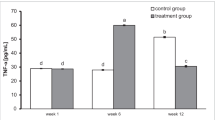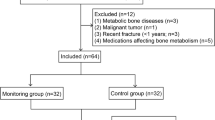Abstract
Purpose
Aseptic loosening is a serious complication after total joint arthroplasty. Plain radiography, along with clinical signs of prosthesis loosening, is the technique of first choice to evaluate loosening of joint replacements. Nevertheless, radiographical signs of osteolysis may not be apparent until progressed stages of loosening. Thus the search for alternative diagnostic methods is of great importance. The purpose of the present study was to evaluate the potential diagnostic significance of TRAP 5b, Osteocalcin, CrossLaps and Bone ALP for aseptic loosening of total joint replacements.
Methods
Thirty-seven patients (25 women, 12 men, mean age 65 years, age range 54–76 years) treated with revision surgery due to clinically and radiologically confirmed late aseptic prosthesis loosening were examined prospectively. Serum levels of TRAP 5b, Osteocalcin, CrossLaps and Bone ALP were compared with a matched control group (n = 39).
Results
We found a significant decrease in TRAP 5B level in patients with aseptic loosening. Bone ALP and Osteocalcin as markers of osteoblast activity, and CrossLaps as another resorption marker did not allow any prediction of bone remodeling in this late phase of loosening.
Conclusion
In the „late“ phase of aseptic joint replacement loosening, no increase of TRAP 5b and therefore no increase of osteoclast number and activity was measurable. Thus, in this situation an anti-osteolytic therapy with a bisphosphonate or denosumab would not gain any further benefit.
Similar content being viewed by others
References
Malchau H, Herberts P, Ahnfelt L (1993) Prognosis of total hip replacement in Sweden. Follow-up of 92,675 operations performed 1978–1990. Acta Orthop Scand 64:497–506
Temmerman OP, Raijmakers PG, Berkhof J, Hoekstra OS, Teule GJ, Heyligers IC (2005) Accuracy of diagnostic imaging techniques in the diagnosis of aseptic loosening of the femoral component of a hip prosthesis: a meta-analysis. J Bone Joint Surg (Br) 87:781–5
Claus AM, Sychterz CJ, Hopper RH Jr, Engh CA (2001) Pattern of osteolysis around two different cementless metal-backed cups: retrospective, radiographic analysis at minimum 10-year follow-up. J Arthroplasty 16:177–82
Wilkinson JM, Hamer AJ, Rogers A, Stockley I, Eastell R (2003) Bone mineral density and biochemical markers of bone turnover in aseptic loosening after total hip arthroplasty. J Orthop Res 21:691–6
Hundric-Haspl Z, Pecina M, Haspl M, Tomicic M, Jukic I (2006) Plasma cytokines as markers of aseptic prosthesis loosening. Clin Orthop Relat Res 453:299–304
Pagani F, Francucci CM, Moro L (2005) Markers of bone turnover: biochemical and clinical perspectives. J Endocrinol Invest 28:8–13
Halleen JM, Alatalo SL, Suominen H, Cheng S, Janckila AJ, Vaananen HK (2000) Tartrate-resistant acid phosphatase 5b: a novel serum marker of bone resorption. J Bone Miner Res 15:1337–45
Halleen JM, Raisanen S, Salo JJ, Reddy SV, Roodman GD, Hentunen TA, Lehenkari PP, Kaja H, Vihko P, Väänänen HK (1999) Intracellular fragmentation of bone resorption products by reactive oxygen species generated by osteoclastic tartrate-resistant acid phosphatase. J Biol Chem 274:22907–10
Savarino L, Avnet S, Greco M, Giunti A, Baldini N (2010) Potential role of tartrate-resistant acid phosphatase 5b (TRACP 5b) as a surrogate marker of late loosening in patients with total hip arthroplasty: a cohort study. J Orthop Res 28:887–92
Halleen J, Hentunen TA, Hellman J, Vaananen HK (1996) Tartrate-resistant acid phosphatase from human bone: purification and development of an immunoassay. J Bone Miner Res 11:1444–52
Chu P, Chao TY, Lin YF, Janckila AJ, Yam LT (2003) Correlation between histomorphometric parameters of bone resorption and serum type 5b tartrate-resistant acid phosphatase in uremic patients on maintenance hemodialysis. Am J Kidney Dis 41:1052–9
Alatalo SL, Peng Z, Janckila AJ, Kaija H, Vihko P, Vaananen HK, Halleen JM (2003) A novel immunoassay for the determination of tartrate-resistant acid phosphatase 5b from rat serum. J Bone Miner Res 18:134–9
Habermann B, Eberhardt C, Feld M, Zichner L, Kurth AA (2007) Tartrate-resistant acid phosphatase 5b (TRAP 5b) as a marker of osteoclast activity in the early phase after cementless total hip replacement. Acta Orthop 78:221–5
Halleen JM, Ylipahkala H, Alatalo SL, Janckila AJ, Heikkinen JE, Suominen H, Cheng S, Väänänen HK (2002) Serum tartrate-resistant acid phosphatase 5b, but not 5a, correlates with other markers of bone turnover and bone mineral density. Calcif Tissue Int 71:20–5
Streich NA, Gotterbarm T, Jung M, Schneider U, Heisel C (2009) Biochemical markers of bone turnover in aseptic loosening in hip arthroplasty. Int Orthop 33:77–82
Garnero P (2014) New developments in biological markers of bone metabolism in osteoporosis. Bone 66C:46–55
Landgraeber S, Loer F, Heep H, Classen T, Grabellus F, Totsch M, von Knoch M (2010) Tartrate-resistant acid phosphatase 5b and C-terminal telopeptides of type I collagen as markers for diagnosis of aseptic loosening after total hip replacement. Arch Orthop Trauma Surg 130:441–5
Ross RD, Virdi AS, Liu S, Sena K, Sumner DR (2014) Particle-induced osteolysis is not accompanied by systemic remodeling but is reflected by systemic bone biomarkers. J Orthop Res 32:967–73
Moghaddam A, Muller U, Roth HJ, Wentzensen A, Grutzner PA, Zimmermann G (2011) TRACP 5b and CTX as osteological markers of delayed fracture healing. Injury 42:758–64
Witzleb WC, Menschikowski M (2001) Urinary concentration of collagen metabolites in endoprosthesis loosening. Z Orthop Ihre Grenzgeb 139:240–4
Author information
Authors and Affiliations
Corresponding author
Rights and permissions
About this article
Cite this article
Maier, G.S., Eberhardt, C., Strauch, M. et al. Is tartrate-resistant acid phosphatase 5b a potent bio-marker for late stage aseptic implant loosening?. International Orthopaedics (SICOT) 38, 2597–2600 (2014). https://doi.org/10.1007/s00264-014-2471-2
Received:
Accepted:
Published:
Issue Date:
DOI: https://doi.org/10.1007/s00264-014-2471-2




